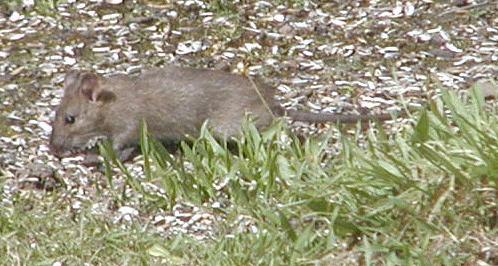‘Giant rats’ in our cities have hit the media headlines in recent weeks and, while ‘rats as big as cats’ are unlikely to be stalking the suburbs, there do seem to be some large and well-fed rats lurking in urban areas. What’s more – the rats that your cat brings home may not be the biggest ones out there, according to international research into cat/rat hunting dynamics.

The research, carried out by James E. Childs, was published in the Journal of Mammalogy back in 1986, making it something of a classic. It’s well worth looking back at, if you’re relying on your cat to keep the biggest rodents at bay.
The study refers to Norway rats, which are the ‘urban’ rat species commonly found in cities in most of the world. New Zealand is unusual in also having the smaller, but long-tailed ship rats (black rats) in our urban environments as well as the larger, water-loving Norway rats investigated here.
The author reports on both observed and indirect evidence for size-dependent predation by urban cats on rats. From the description provided, hanging out in alleys researching rats doesn’t sound the most glamorous of research projects.
“Data on interactions between rats and cats were gathered in three alleys located in residential areas of high human population density in Baltimore, Maryland, from September 1980 through May 1982. Approximately 912 hours of observation were made from automobiles parked in alleys during bi-weekly visits to study sites. Observation periods were initiated within 1 hour after dark and continued for 3-4 hours, during which time Norway rats were concomitantly collected in alleys by use of Tomahawk live traps. Alleys were dimly illuminated by street lights and detailed observations of cat and rat interactions were limited to approximately 15 metres.”
The author also collected rats killed by alley cats.
“Rats killed by cats were collected by three methods. First, after I witnessed predation, cats were pursued and captured rats were collected from fleeing cats. Second, home owners with pet cats were asked to save rat carcasses brought home by their free-ranging pets. Third, litters of stray kittens were located, and these den sites were visited once or twice a week to collect dead rats brought to the young by attending female cat(s). All rat carcasses were weighed, and the amount and type of tissue ingested by cats were noted. In cases where rats were partially eaten, estimates of total body weight were made based on the percentage of parts missing. Rats captured in live traps were anesthetized with ether prior to being sacrificed and processed as with the rat carcasses.”
“Twenty-seven rat carcasses were collected and examined over the study period; three following observed cat predation (five predation events on rats witnessed, three successful recoveries), seven from household cats, and 17 recovered from three den sites occupied by litters of kittens belonging to stray cats. Of the 27 rat carcasses, 22 (81.5%) were sufficiently intact to be weighed. These 22 animals were juvenile or young adults weighing less than 200 g. The distribution of weights of cat-killed rats differed from the distribution of weights of live-trapped rats. In the trapped sample only 10 of 109 (9.2%) rats weighed less than 200 g; mean weight of trapped rats was 392.9. (range 55.4-610.0 g).”
All of which shows there were some very big Norway rats out there and the cats weren’t touching them!
“Of the 24 rat carcasses that were obtained without interruption of observed predation, 11 (45.8%) were not eaten, 8 (33.3%) were partially eaten, and 5 (20.8%) were totally consumed with the exception of head, skin, tail, and feet. The most commonly consumed tissues of partially eaten rats were brain (6/8), muscles of neck and back (4/8), and entrails (2/8).”
So why are cats avoiding the ‘bigger meals’. Possibly because big rats fight back and the cats had learnt to be cautious.
“In this study, cats invariably preyed upon rats that can be considered juvenile or subadult, as was suggested by the difference between the distributions of rat weight based on trapping results and the collection of cat prey. The basis for this size selection is not certain, but several points may be considered:

- Although adult cats and large rats were frequently observed in close proximity, no aggressive behaviour was directed by rats towards cats, and generally these species coexist peacefully in alleys.
- I witnessed adult cats pursuing large rats on only five occasions and pursuits always terminated prior to physical contact. It is possible that cats had learned previously not to consummate attacks on adult rats, but still occasionally pursued these animals.
- Rat-killing in cats is a trait that may depend on early experience and learning and it is possible that in urban environments, where food resources are plentiful, few cats rely on rat predation. A large percentage of free-ranging cats are known to have been owned at one time and therefore may have had no early experience with rat-killing.”
Whatever the reason, the evidence seems to point towards cats avoiding large rats and specifically targeting younger and smaller individuals.
“The complete absence of large rats in the cat-killed sample, coupled with the avail ability of this segment of the population, strongly suggests size-dependent selection of rats by cats.”
So the message for urban New Zealanders when big Norway rats appear in the suburbs – don’t rely on your cat to deal with it. You’ll probably need to trap the big ones yourself.
The original research paper was published in the Journal of Mammology.
Size-Dependent Predation on Rats (Rattus norvegicus) by House Cats (Felis catus) in an Urban Setting (1986)

